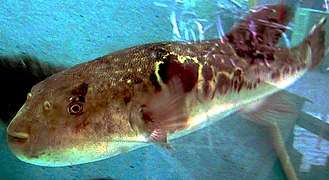Takifugu rubripes
Takifugu rubripes, commonly known as the Japanese puffer, Tiger puffer, or torafugu (Japanese: 虎河豚), is a pufferfish in the genus Takifugu. It is distinguished by a very small genome that has been fully sequenced because of its use as a model species and is in widespread use as a reference in genomics.[3]
| Takifugu rubripes | |
|---|---|
 | |
| Scientific classification | |
| Kingdom: | Animalia |
| Phylum: | Chordata |
| Class: | Actinopterygii |
| Order: | Tetraodontiformes |
| Family: | Tetraodontidae |
| Genus: | Takifugu |
| Species: | T. rubripes |
| Binomial name | |
| Takifugu rubripes | |
| Synonyms | |
| |
Taxonomy and etymology
The species is often referred to in the genomics literature as Fugu rubripes. The genus Fugu is a synonym of the currently preferred Takifugu.[4] Takifugu is Japanese for puffer and rubripes comes from the Latin ruber and pēs meaning ruddy foot.
Distribution and habitat
The species is known from the Sea of Japan, East China Sea and Yellow Sea north to southern Sakhalin, at depths of 10–135 m (33–443 ft). It is a demersal species. Spawning occurs in estuaries; young fish can tolerate a wide range of salinities and will remain in river mouths and lagoons, maturing for one year before migrating permanently to the open ocean.[1]
Genome
A feature of this species is that it has a very small genome, which is used as a ‘reference’ for identifying genes and other elements in human and other vertebrate genomes. The genome was published in 2002 by the International Fugu Genome Consortium via whole genome shotgun sequencing. After being initiated in 1989, it was the first vertebrate genome after the human genome to be made publicly available.[5] It remains among the smallest known vertebrate genomes; its number of base pairs is ~6% and the number of previously known protein-coding genes ~13% that of the human genome, although the number of chromosomes (22) is comparable to that of humans (23). This makes it particularly useful for comparative studies. Current estimates show a total of 392,376,244 base pairs, 1,138 known and 18,093 novel protein-coding genes, and 593 RNA genes.[6]
Toxicity
As some other pufferfish, some organs of the Japanese puffer contain tetrodotoxin and are highly toxic. The toxin is highly concentrated in liver and ovaries, slightly present in the intestines and flesh, and absent from skin and testes.[1]
Conservation
The Japanese puffer is classified as Near Threatened by the IUCN. It is one of the most valuable commercial fishes in Japan, and although current catches (101 tonnes / year in 2004, down from a peak of 2,000 tonnes in 1987) are small compared to those of many other commercial species such as sardines and anchovy, they appear to be unsustainable and prevent the recovery of the species from earlier over-exploitation. Gear restrictions (most catches occur by longline fishing) and adjustments of fishery seasons to protect juveniles have been recommended to aid recovery. The species is extensively raised in aquaculture.[1]
Internet popularity
In 2019, a video by Korean youtuber Yummyboy of a Japanese puffer became a viral internet meme. In the video, a puffer is fed a carrot to demonstrate their strong bite, and then proceeds to say "aeugh." The fish is then killed and prepared into fugu.
References
- Shao, K., Liu, M., Jing, L., Hardy, G., Leis, J.L. & Matsuura, K. (2014). IUCN Red List of Threatened Species. 2014: e.T193612A2247747. doi:10.2305/IUCN.UK.2014-3.RLTS.T193612A2247747.en. Missing or empty
|title=(help)CS1 maint: uses authors parameter (link) - "ITIS Standard Report Page: Takifugu rubripes". Itis.gov. 2004-05-13. Retrieved 2016-05-05.
- Holmes, Bob (2018). "A master teller of fish stories". Knowable Magazine. doi:10.1146/knowable-050918-050001.
- Keiichi Matsuura (1990). "The pufferfish genus Fugu Abe, 1952, a junior subjective synonym of Takifugu Abe, 1949". Bull. Natn. Sci. Mus., Tokyo, Ser. A. 16: 15–20.
- "Fugu Genome Project: IMCB, A*STAR, Singapore". www.fugu-sg.org. Archived from the original on 2001-10-26. Retrieved 2016-12-05.
- Kai, Wataru; Kikuchi, Kiyoshi; Tohari, Sumanty; Chew, Ah Keng; Tay, Alice; Fujiwara, Atushi; Hosoya, Sho; Suetake, Hiroaki; Naruse, Kiyoshi (2011-01-01). "Integration of the Genetic Map and Genome Assembly of Fugu Facilitates Insights into Distinct Features of Genome Evolution in Teleosts and Mammals". Genome Biology and Evolution. 3: 424–442. doi:10.1093/gbe/evr041. ISSN 1759-6653. PMC 5654407. PMID 21551351.
External links
| Wikispecies has information related to Takifugu rubripes |
